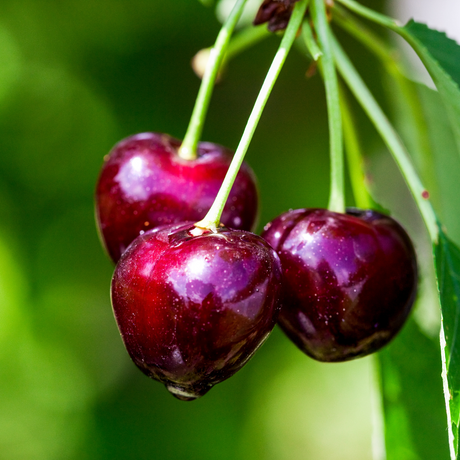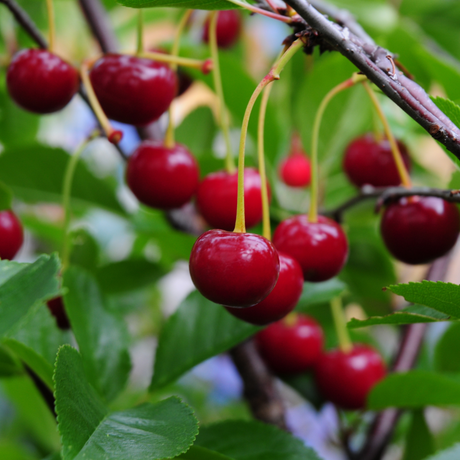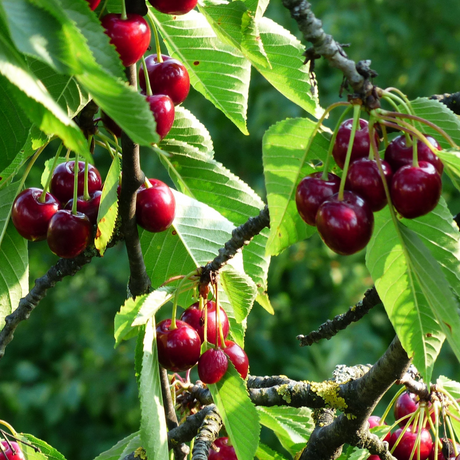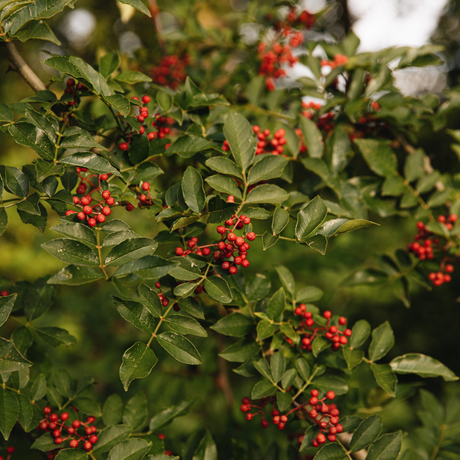Low stem cherry tree 'Regina' BIO
€27,72Unit price /UnavailableLow-stemmed cherry tree 'Sunburst' BIO
€27,72Unit price /UnavailableLow stem cherry tree 'Burlat' BIO
€27,72Unit price /UnavailableLow stem cherry tree 'Bigarreau Napoleon' BIO
€27,72Unit price /UnavailableLow stem cherry tree 'Morellenfeuer'/'Noordkriek' BIO
€27,72Unit price /Unavailable
Cherry trees in pictures
In this video, Ruud shows how to plant a tree.

Also read our growing guide on choosing and planting fruit trees.
You may also like
View allBuy a cherry tree – blossom and fruit pleasure for your garden
Buying a cherry tree means choosing years of garden enjoyment. In spring, it blossoms beautifully, and in summer, it yields juicy cherries for sweet treats. From sweet table cherries to slightly tart culinary varieties – there's something for everyone. And the best part: a cherry tree doesn't require excessive maintenance, yet it delivers a wealth of enjoyment.
A cherry tree is a fruit tree, and there's a wide variety of cherry tree varieties available in various sizes. When buying cherry trees, consider the available space in your garden and your personal preferences, so you'll always find the perfect cherry tree.
Why you should choose a cherry tree
- Blossom and harvest – first color and scent, later fruit to savor
- Tasty fruit – fresh, in pie or as juice
- Variety Options – There are several varieties of cherry trees, including the self-pollinating variety, and you can choose self-pollinating or pollinated, sweet or sour
- Little work – with sun, air and a little pruning you can go a long way
- Long lifespan – a healthy tree can produce fruit for decades
A cherry tree is therefore an excellent choice for those who want to enjoy blossoms and fruit for years to come.
Our favorite cherry trees
- Low-stemmed cherry tree 'Regina' BIO: sweet, deep-red cherries with a firm bite and a late harvest. A winner for those who want to enjoy flavorful fruit for a long time.
- Low-stemmed cherry tree 'Sunburst' BIO: large, juicy cherries with a mild, sweet flavor. Self-pollinating and wonderfully easy to care for.
- Low-stemmed cherry tree 'Burlat' BIO: early harvest, glossy red fruit, and exceptionally juicy. A classic for those who can't wait for summer.
- Low-stemmed cherry tree 'Bigarreau Napoleon' BIO: yellow with a red blush, firm and deliciously sweet. This eye-catching tree tastes as good as it looks.
- Low-stemmed cherry tree 'Morellenfeuer'/'Noordkriek' BIO: a compact tree with sour cherries full of character. Ideal for jam, juice, or a real cherry tart.
There are different types of cherry trees, such as dwarf, half-standard, and standard. A dwarf cherry tree is perfect for a small garden or smaller gardens, while a standard or large cherry tree is suitable for larger gardens. Half-standard cherry trees offer a good compromise, with the first branches at a convenient height, making picking easy. A mini cherry tree is an excellent option for the balcony or in a pot.
Cherry trees are characterized by their trunks, large leaves, and beautiful white blossoms in spring. When ordering a cherry tree, you can choose from a wide selection, so you're sure to find the one that best suits your garden.
When planting a cherry tree in the open ground, ensure good soil, healthy roots, and proper establishment of the plant. With proper care, such as pruning and keeping the cherry tree small, you'll ensure a good harvest and healthy fruit. Some varieties, such as non-self-pollinating cultivars, require another cherry tree for cross-pollination.
The difference between a dwarf, half-standard, and standard cherry tree lies in the height and location of the first branches; these are available in various sizes, suitable for any garden. Harvest the cherry in time to prevent the fruit from falling to the ground.
Planting instructions and care
Planting a cherry tree and proper care
- Location – Choose a spot in full sun with good air circulation. When planting cherry trees in the ground, it's important to ensure good soil and sufficient space for the roots to develop.
- Soil – airy, fertile, and well-drained (no excess water). Proper soil preparation and planting ensure optimal carrot development, which is essential for healthy growth.
- Planting time – Autumn or early spring is the ideal time to plant cherry trees. This gives the plant the best chance to establish roots and establish itself.
- Pruning – after harvest: Remove old, dead, or diseased branches to keep light in the crown. Pruning properly and keeping the cherry tree small contributes to a good harvest and healthy fruit production.
- Pollination – Pay close attention to the pollination requirements of your variety. Some cherry trees are self-pollinating, while others require a partner.
Want to order a cherry tree or multiple cherry trees? When planting, you can choose from various options, such as a standard tree, espalier, or a plant for pots or open ground. This way, you're sure to find a cherry tree that suits your garden and needs.
Pruning cherry trees – for healthy growth and a rich harvest
Pruning your cherry tree is truly the secret to a healthy tree and an abundant harvest of sweet cherries. Especially with those beautiful tall-stemmed cherry trees and self-pollinating varieties, it's so helpful to trim them every year – your tree stays healthy and produces those delicious fruits year after year. The best time? Immediately after harvest, in the summer. This way, your tree has the least chance of disease and can recover beautifully.
Simply start by cutting away those dead, diseased, or crossed branches—you know, that junk that shouldn't be there. This allows light and air to reach the crown, which is exactly what your tree needs for new growth and even more sweet cherries. If you have a large trunk, take it easy on the pruning—overdoing it isn't wise, as you naturally want to avoid stress. Your self-pollinating trees will also appreciate regular pruning, ensuring they remain brimming with cherries year after year. With the right pruning, you'll have a beautiful tree that not only looks healthy but also rewards you with those delicious cherries you love so much.
Bloom – the magical moment in your garden
Your cherry tree in bloom? It's a real treat in your garden every spring. Around April, my tree transformed into a veritable cloud of white blossoms—as if it's all dressed up for spring. And it's not just you who's happy; the bees are crazy about it too. Those blossoms are actually the starting signal for all those delicious cherries you'll soon be eagerly picking.
Just make sure your tree is in a sunny spot and give it plenty of water and nutrients during flowering – just like you need your morning coffee. And don't forget the pruning, as this gives your blossoms plenty of room to flourish. This way, you'll not only have a beautiful tree to admire, but also the promise of a summer full of sweet cherries. The blossoming of your cherry tree truly signals the beginning of months of gardening joy and a delicious harvest. Enjoy!
Harvesting & Use
Cherries usually ripen between June and July, depending on the variety. It's best to pick them as soon as they're ripe to prevent them from falling to the ground and thus maintain a good harvest. They're delicious fresh, but you can also use them in jam, pie, or juice. And remember: you can also freeze cherries for later use.
For small and large gardens
There's a suitable cherry tree for every garden, from small to large: you can choose a small cherry tree, a standard cherry tree, or a large cherry tree. Standard cherry trees and smaller cherry tree varieties are ideal for small gardens because they take up less space and are easy to maintain. For larger gardens, half-standard and standard cherry trees are very suitable. A potted cherry tree is an excellent option for those with a smaller garden. When choosing a cherry tree, always consider what best suits your garden. This way, you can enjoy the fruit you planted and cared for yourself every year.
































